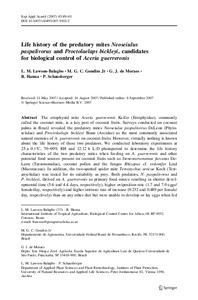| dc.contributor.author | Lawson-Balagbo, L.M. |
| dc.contributor.author | Gondim Jr, M.G.C. |
| dc.contributor.author | Moraes, G.J. de |
| dc.contributor.author | Hanna, R. |
| dc.contributor.author | Schausberger, P. |
| dc.date.accessioned | 2019-12-04T11:14:15Z |
| dc.date.available | 2019-12-04T11:14:15Z |
| dc.date.issued | 2007-09 |
| dc.identifier.citation | Lawson-Balagbo, L.M., Gondim, M.G.C., De Moraes, G.J., Hanna, R. & Schausberger, P. (2007). Life history of the predatory mites Neoseiulus paspalivorus and Proctolaelaps bickleyi, candidates for biological control of Aceria guerreronis. Experimental and Applied Acarology, 43(1), 49-61. |
| dc.identifier.issn | 0168-8162 |
| dc.identifier.uri | https://hdl.handle.net/20.500.12478/2704 |
| dc.description | Published online: 08 Sept 2007 |
| dc.description.abstract | The eriophyoid mite Aceria guerreronis Keifer (Eriophyidae), commonly called the coconut mite, is a key pest of coconut fruits. Surveys conducted on coconut palms in Brazil revealed the predatory mites Neoseiulus paspalivorus DeLeon (Phytoseiidae) and Proctolaelaps bickleyi Bram (Ascidae) as the most commonly associated natural enemies of A. guerreronis on coconut fruits. However, virtually nothing is known about the life history of these two predators. We conducted laboratory experiments at 25 ± 0.1°C, 70–90% RH and 12:12 h L:D photoperiod to determine the life history characteristics of the two predatory mites when feeding on A. guerreronis and other potential food sources present on coconut fruits such as Steneotarsonemus furcatus DeLeon (Tarsonemidae), coconut pollen and the fungus Rhizopus cf. stolonifer Lind (Mucoraceae). In addition, the two-spotted spider mite Tetranychus urticae Koch (Tetranychidae) was tested for its suitability as prey. Both predators, N. paspalivorus and P. bickleyi, thrived on A. guerreronis as primary food source resulting in shorter developmental time (5.6 and 4.4 days, respectively), higher oviposition rate (1.7 and 7.0 eggs/female/day, respectively) and higher intrinsic rate of increase (0.232 and 0.489 per female/day, respectively) than on any other diet but were unable to develop or lay eggs when fed T. urticae. Coconut pollen and S. furcatus were adequate alternative food sources for N. paspalivorus and Rhizopus for P. bickleyi. We discuss the relevance of our findings for natural and biological control of the coconut mite A. guerreronis. |
| dc.format.extent | 49-61 |
| dc.language.iso | en |
| dc.subject | Coconut |
| dc.subject | Aceria Guerreronis |
| dc.subject | Biological Control |
| dc.subject | Predatory Pests |
| dc.title | Life history of the predatory mites Neoseiulus paspalivorus and Proctolaelaps bickleyi, candidates for biological control of Aceria guerreronis |
| dc.type | Journal Article |
| dc.description.version | Peer Review |
| cg.contributor.affiliation | International Institute of Tropical Agriculture |
| cg.contributor.affiliation | Universidade Federal Rural de Pernambuco |
| cg.contributor.affiliation | University of São Paulo |
| cg.contributor.affiliation | University of Natural Resources and Life Sciences, Austria |
| cg.coverage.region | South America |
| cg.coverage.country | Brazil |
| cg.creator.identifier | Rachid Hanna: 0000-0002-5715-0144 |
| cg.isijournal | ISI Journal |
| cg.authorship.types | CGIAR and developing country institute |
| cg.iitasubject | Biodiversity |
| cg.iitasubject | Pests Of Plants |
| cg.journal | Experimental and Applied Acarology |
| cg.howpublished | Formally Published |
| cg.accessibilitystatus | Limited Access |
| local.dspaceid | 93632 |
| cg.targetaudience | Scientists |

